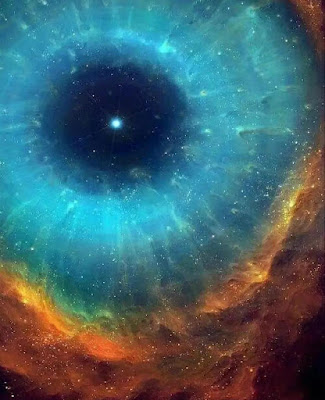The Helix Nebula is believed to have formed from a star that was once similar in mass to the Sun. As the star began to run out of fuel and its core began to contract, the outer layers of the star began to expand and cool. Eventually, the star shed its outer layers entirely, leaving behind a hot, dense core known as a white dwarf. The material that was ejected from the star formed a glowing shell around the white dwarf, which we observe as the Helix Nebula today.
The Helix Nebula is estimated to be about 650 light-years from Earth and has a diameter of approximately 2.5 light-years. It is visible to the naked eye as a faint, grayish-blue object, but its intricate structure is best observed through telescopes or in photographs. The nebula's distinctive shape is due to the complex interactions between the ejected material and the surrounding interstellar medium.
The most striking feature of the Helix Nebula is its central region, which appears as a bright, circular ring surrounding the white dwarf at the center of the nebula. This ring, which is sometimes referred to as the "Eye of God," is actually a torus-shaped structure that is tilted toward Earth. The torus is made up of ionized gas that is being heated by the intense radiation from the white dwarf at the center of the nebula.
Surrounding the central torus are several layers of gas and dust that have been expelled from the dying star. These layers form a series of concentric rings that are oriented perpendicular to the torus. The rings are created by shock waves that are generated as the high-energy radiation from the white dwarf collides with the surrounding gas and dust. These shock waves compress the material and cause it to glow brightly.
The outermost layer of the Helix Nebula is a faint, filamentary structure that extends far beyond the central region of the nebula. This outer layer is thought to be composed of material that was expelled from the star before it formed the central torus. The material in this outer layer is moving away from the center of the nebula at high speeds, which has caused it to stretch out into long, filamentary strands.
In addition to its striking appearance, the Helix Nebula is of great scientific interest because it provides a window into the final stages of the evolution of stars like our Sun. By studying the nebula, astronomers can learn about the processes that occur as a star transitions from its main sequence phase to its death as a white dwarf. In particular, the Helix Nebula is important because it is a relatively young planetary nebula, meaning that the material in the nebula has not yet had time to disperse and mix with the surrounding interstellar medium. This makes it easier for astronomers to study the properties of the nebula and the star that created it.
One of the most important discoveries that has been made through the study of the Helix Nebula is the presence of complex organic molecules in the nebula's central region. These molecules, which include formaldehyde and hydrogen cyanide, are the building blocks of life on Earth and suggest that similar organic compounds may be present in other planetary nebulae and in the early stages of star formation. The presence of organic molecules in the Helix Nebula also raises the tantalizing possibility.







No comments:
Post a Comment
If you have any doubts, Please let me know.